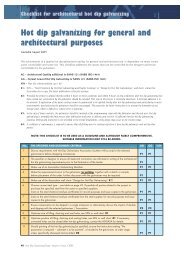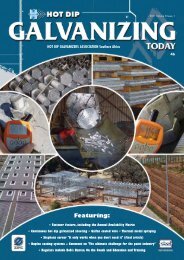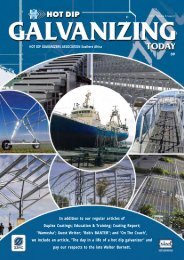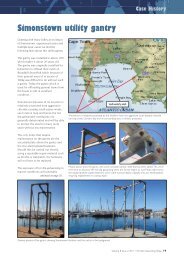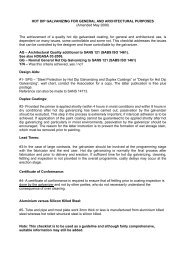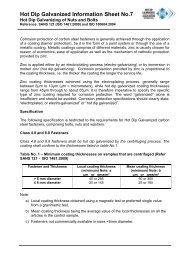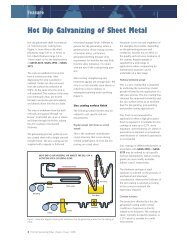Featuring: - hdgasa
Featuring: - hdgasa
Featuring: - hdgasa
Create successful ePaper yourself
Turn your PDF publications into a flip-book with our unique Google optimized e-Paper software.
Masts, poles and sign gantries<br />
Materials / coatings used in the utility pole<br />
market – summary of a 2006 survey<br />
The following summary of the different<br />
materials used, was taken from a report<br />
produced in 2006 of the Utility Pole<br />
Market.<br />
Photo 1: Without the correct treatment<br />
timber light poles can rot at the base.<br />
Lighting poles<br />
The market estimate for steel lighting<br />
poles in 2006 was about 4 000 tpa.<br />
However, it was expected that substantial<br />
growth in this market (mainly<br />
infrastructural (township) development<br />
and replacement – accidents,<br />
corrosion, etc.) was likely to occur.<br />
Competitor materials are wood,<br />
concrete and fibreglass. Over 70% of<br />
the steel poles are of standard length.<br />
Market control is via the tender system<br />
with 90% of the municipalities<br />
specifying steel. Most steel poles are<br />
hot dip galvanized and then solution<br />
painted or powder-coated for use in<br />
aggressive conditions. Current<br />
specification control is either local<br />
municipality or SABS 0225.<br />
For the total market it is estimated<br />
that steel represents 64%, concrete<br />
18%, fibreglass 18%. Further<br />
information is available from the<br />
Institute of Lighting Engineers.<br />
Discussions with specifiers/users and<br />
fabricators indicated that the following<br />
material issues were important.<br />
Wood<br />
◆ Municipalities only really use wood if<br />
they have a lot of it currently in stock.<br />
◆ Wood has to be treated and bitumen<br />
is applied at the base, to prevent rot.<br />
See photo 1.<br />
◆ Problem with cable access (need to<br />
cut a groove or strap a conduit).<br />
◆ Need to cut a housing.<br />
◆ Life considered good.<br />
◆ Good structural reliability (often<br />
reused).<br />
◆ Slightly cheaper than steel.<br />
◆ Easy to transport, but heavier than<br />
steel.<br />
◆ Problems are with attachments<br />
(outreach arms, etc), which tend to be<br />
made of hot dip galvanized steel.<br />
Photo 2: Outreach arms are usually hot dip<br />
galvanized steel. Care should be taken that<br />
fasteners also be hot dip galvanized for long<br />
term corrosion control.<br />
Photo 3: GRP light post with stainless steel<br />
sleeve.<br />
Photo 4: GRP light post where outer fibres<br />
have been exposed in the premature<br />
breakdown of the pole.<br />
Photo 5: Outreach arms on concrete poles are<br />
usually hot dip galvanized steel. Ensure all<br />
fasteners are hot dip galvanized and not zinc<br />
electroplated for long maintenance free life.<br />
Photo 6: Cables are attached to the outside<br />
faces of the concrete pole, limiting its<br />
aesthetical appeal.<br />
Photo 7: Concrete poles often need outside<br />
junction boxes to accommodate incoming<br />
cables.<br />
24 Hot Dip Galvanizing Today Volume 4 Issue 3 2007



